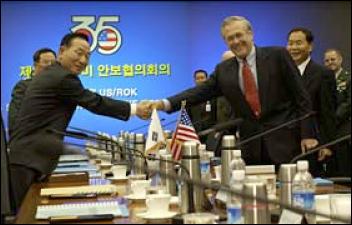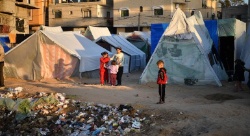U.S. to Reorganize Forces in Korea Around Two Hubs
By Kathleen T. Rhem
American Forces Press
Service

Secretary of Defense
Donald H. Rumsfeld shakes hands with South Korean Minister
of National Defense Cho during the Security Consultative
Meeting at the War Museum in Seoul, South Korea, Nov. 17.
The visit was part of the secretary's week-long visit to the
Pacific Rim to meet with government officials and U.S.
service members. Defense Department photo by Air Force Tech.
Sgt.
SEOUL, South Korea, Nov. 18, 2003 – American military forces in South Korea need to transform to defend against changing threats in today's world, the general in charge of U.S. and combined forces in that country said.
"(Sept. 11) changed the way the United States viewed the world and viewed its adversaries," Army Gen. Leon LaPorte said. "We now know we need to change the way we do business around the world."
LaPorte is the commander of the United Nations and Combined Forces commands here, in addition to U.S. Forces Korea. He took time Nov. 17 to explain important issues on the peninsula to reporters traveling with Defense Secretary Donald Rumsfeld on his visit to Asia.
Rumsfeld is in Korea to meet with government officials for an annual Security Consultative Meeting. During a joint press conference with his Korean counterpart, Minister of National Defense Cho Yung Kil, Nov. 17, Rumsfeld called this year's meeting "one of the most substantive … ever."
"As the U.S. and Korea look at the 21st-century challenges and the new security environment we're in, we're working to transform our combined military posture to defend Korea and to strengthen security and prospects for peace on this peninsula," he said.
American forces in Korea are preparing for a radical change in the footprint. For 50 years, since the armistice that ended the Korean War, U.S. troops have occupied nearly 100 camps and stations in the southern half of the Korean Peninsula. After the coming reorganization, those troops will be concentrated around two major hubs.
LaPorte explained that the large number of camps resulted from the circumstances at the end of the war. "(U.S. forces) basically went to ground where we were during armistice," he said. "And for 50 years, these camps and stations have deteriorated, and it is cost-prohibitive to maintain these."
Consolidating forces will allow for greater efficiency and economy of scale, he said. "By consolidating into enduring installations, we can maximize investment and provide better quality of life, better training opportunities and better readiness."
U.S. and Korean officials have agreed to allow the reorganization proceed in two phases: consolidation and relocation.
The majority of American combat power in Korea, the 2nd Infantry Division, is scattered among 17 bases in the northern part of the country. The first phase will consolidate these forces into a more amalgamated footprint in the north. The second phase will involve the move of all U.S. forces in the country to the southern region.
The second phase will also involve moving the roughly 7,000 U.S. troops out of the Seoul area. "Twenty years ago, perhaps we needed 7,000 to execute our military mission," LaPorte said. "But today, because of the technologies we have, we could probably do our mission better with significantly less."
No timeframe has been set for any changes. Officials are still examining options. "The big slowdown in moving out of Seoul is you have to purchase land and build facilities," the general explained. "There're no facilities readily available for these 7,000 service members to move into."
He said there is still likely to be a U.S. presence in Seoul after the reorganization, but final levels have not been agreed upon.


 UN News: 10,000 People Feared Buried Under The Rubble In Gaza
UN News: 10,000 People Feared Buried Under The Rubble In Gaza Save The Children: Heat-stricken Bangladesh Extends School Closures
Save The Children: Heat-stricken Bangladesh Extends School Closures Hayden Stephens and Associates: Record Class Action Settlement Gives Hope To 50,000 Australian Junior Doctors
Hayden Stephens and Associates: Record Class Action Settlement Gives Hope To 50,000 Australian Junior Doctors UN News: Healing Page By Page In Earthquake-affected Türkiye
UN News: Healing Page By Page In Earthquake-affected Türkiye Save The Children: Rate Of Attacks On Healthcare in Gaza Higher Than In Any Other Conflict Since 2018
Save The Children: Rate Of Attacks On Healthcare in Gaza Higher Than In Any Other Conflict Since 2018 UN News: Green Light For New Cholera Vaccine, Ukraine Attacks Condemned, Action Against Racism
UN News: Green Light For New Cholera Vaccine, Ukraine Attacks Condemned, Action Against Racism